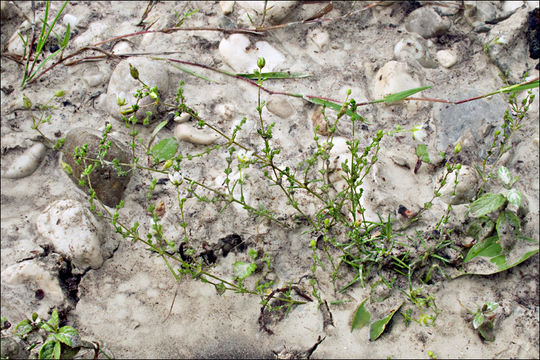Слика од Sagina nodosa (L.) Fenzl

Опис:
Slo.: velecvetni pitomec - Habitat: river shore, abandoned gravel and sand excavation quarry, semiruderal calcareous ground, flat and lightly overgrown terrain, dominant plants: young Salix purpurea and Alnus incana, sunny place, exposed to direct rain, average precipitations ~ 3.000 mm/year, average temperature 8-10 deg C, elevation 340 m (1.100 feet), alpine phytogeographical region. - Substratum: young alluvial gravel, pebbles, sand and silt. - Comment: Sagins nodosa, low, tiny, inconspicuous plant, blending well with others around, is hard to find and not really 'photogenic'. This eurosiberian boreo-temperate botanic element is at home in north Europe: like all over the Island, Scandinavia and Britain but also in north USA and Canada. It loves open space, moist, calcareous, sandy habitats in low land regions. In some places like in Britain it is in sharp decline after the mid of previous century. In Slovenia it was unknown until, in 1967, emeritus professor Dr. T. Wraber found an interesting Sagina, high in the Alps, on Mt. isti vrh, 1.875 m above Trenta valley, just a few km away of my home. The plant was later, based on herbarium specimen, determined as the first observation of Sagina nodosa in Slovenia. Yet, it hasn't been found again neither on Mt. isti vrh nor anywhere else for almost 50 years. - In August 2011 I accidentally encounter Dr. Nejc Jogan from Biotechnical Faculty, University of Ljubljana botanizing along the banks of river Soa near Bovec. Happy and excited he explained me that he had just found the second observation of Sagina nodosa in Slovenia. A few tiny plants were growing in the sand and silt of lightly overgrown river deposits some 10 m away of the river shore. Next day I spent up- and downstream of the original observation, trying to find more plants. Actually I found many of them on three other places in the vicinity. Just two weeks later, after the news spread among botanists, Dr. Igor Dakskobler found it also near town Tolmin some 30 kilometers south and downstream the river. As far as I know, his observation represents, at the moment, the most southern known location of this species in central and east Europe. All these observations, in very short time, are proving that this species is well settled in the region and that it's not such an extreme rarity in Slovenia as supposed before. It seems that the plant has been simply overlooked during more than 250 years of botany field research in Slovenia. Namely, it is unlikely that the plant settled in the upper Posoje just recently. Evident warming of the climate in Posoje during last decades would only push S. nodosa north, not south. - Ref.: (1) T. Wraber, Rastlinoslovne raziskave v Triglavskem narodnem parku (Floristic Research in Triglav National Park). V Bizjak, J. & M. olar (ur. /Eds.): Dvajset let pozneje: 1981-2001. 20 let zakona o Triglavskem narodnem parku (Twenty Years Later: 1981-2001, 20 Years of TNP Law), TNP (2001). 63-73, Triglavski narodni park, Bled. (2) http://www.brc.ac.uk/plantatlas/index.php?q=node/1493 (3) A. Martini et all., Mala Flora Slovenije, Tehnina Zaloba Slovenije (1999), p 148.
Се јавува на следниве страници:
- Life
- Cellular
- Eukaryota (еукариот)
- Archaeplastida
- Chloroplastida
- Spermatophytes (семени растенија)
- Angiosperms (дикотиледони)
- Eudicots
- Superasterids
- Caryophyllales (каранфиловидни)
- Caryophyllaceae (каранфили)
- Sagina
- Sagina nodosa
Сликата ја нема во ниедна збирка.
Информации за изворот
- лиценца
- cc-by-nc-sa-3.0
- авторски права
- 2014 Dr. Amadej Trnkoczy
- фотограф
- Dr. Amadej Trnkoczy
- изворно
- изворна податотека
- посети извор
- соработничко мреж. место
- CalPhotos
- ID


